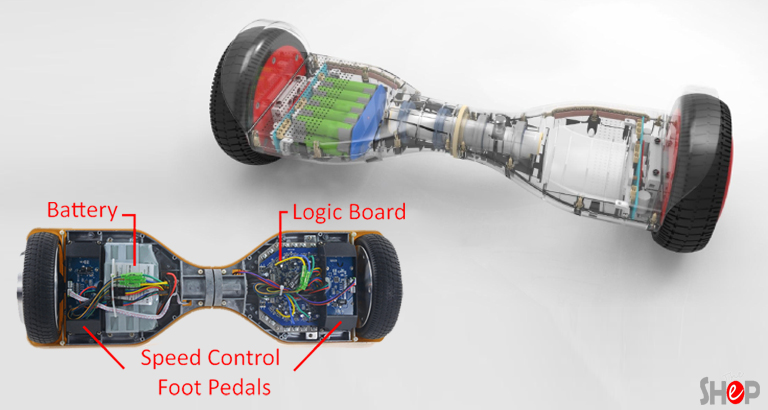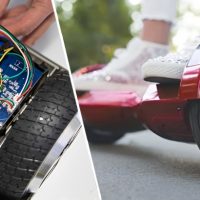Hoverboards have become a popular mode of transportation for people of all ages. They are fun, easy to use, and allow users to move around quickly and efficiently. But what makes these devices work? How do they manage to stay upright and move in the direction that the user wants to go? In this article, we will explore the technology behind hoverboards and look at the components that make them function.

What is a Hoverboard?
A hoverboard is a two-wheeled self-balancing scooter that uses gyroscopes, accelerometers, and microprocessors to maintain balance and stability. It has a flat platform for the rider to stand on, and the wheels are positioned on either end. The rider controls the movement and direction of the hoverboard by shifting their weight.
How Does a Hoverboard Work?
Hoverboards use a combination of gyroscopes, accelerometers, and electric motors to stay balanced and move in the direction that the user wants to go. The gyroscopes and accelerometers are located within the hoverboard’s motherboard, which is responsible for processing data and controlling the device’s movement. When a user leans forward or backward, the gyroscopes detect the change in balance and send a signal to the motherboard, which then adjusts the speed of the electric motors to move the hoverboard in the corresponding direction.
The technology behind hoverboards:
The technology behind hoverboards is complex and relies on several key components. These components include:
- Gyroscopes: Gyroscopes are devices that detect changes in angular momentum. They are used in hoverboards to detect changes in balance and adjust the speed of the electric motors accordingly.
- Accelerometers: Accelerometers are sensors that detect changes in velocity. They are used in hoverboards to detect changes in speed and direction.
- Electric motors: Electric motors are responsible for powering the hoverboard and moving it in the desired direction. They are controlled by the motherboard, which adjusts their speed based on the signals received from the gyroscopes and accelerometers.
- Batteries: Hoverboards are powered by rechargeable batteries that provide the necessary energy to run the electric motors and control the motherboard.
The components of a hoverboard:
Hoverboards are made up of several key components that work together to keep the device balanced and moving in the desired direction. These components include:
- Footpads: Footpads are the flat surfaces on which the user stands. They contain pressure sensors that detect when the user is applying weight to the device.
- Wheels: Hoverboards have two wheels that are connected to the electric motors. These wheels are responsible for moving the device in the desired direction.
- Shell: The shell is the outer casing of the hoverboard. It protects the internal components from damage and also gives the device its sleek and stylish appearance.
Safety considerations when riding a hoverboard:
While hoverboards are a fun and exciting mode of transportation, they can also be dangerous if not used properly. To ensure that you stay safe while riding a hoverboard, it is important to:
- Wear protective gear: Always wear a helmet and other protective gear, such as knee and elbow pads, when riding a hoverboard.
- Choose the right terrain: Hoverboards are designed for use on flat surfaces, so avoid riding them on uneven or bumpy terrain.
- Stay within your limits: Hoverboards can reach high speeds, but it is important to stay within your skill level and only ride at a speed that you are comfortable with.
- Follow local laws: Check your local laws

How to Make a Hoverboard?
Making a hoverboard is not a simple task and requires a combination of skills in electronics, programming, and mechanics. It involves selecting the right components, assembling them, and programming the microcontroller to control the motors and sensors.
Here are the basic steps involved in making a hoverboard:
- Gather the components – This includes the motors, batteries, microcontroller, sensors, and other electronic components.
- Assemble the frame – The frame should be sturdy and lightweight to support the weight of the rider.
- Install the motors and wheels – The motors should be attached to the wheels and connected to the microcontroller.
- Install the batteries – The batteries should be securely mounted inside the frame and connected to the motors and microcontroller.
- Program the microcontroller – The microcontroller should be programmed to control the motors and sensors.
- Test and calibrate the hoverboard – Once the hoverboard is assembled, it should be tested to ensure that it works correctly. The sensors and motors may need to be calibrated to ensure proper balance and stability.
Conclusion:
Hoverboards are an amazing example of how technology can be used to create new and exciting forms of transportation. By using the principles of magnetic levitation and advanced sensors and microprocessors, hoverboards are able to levitate and move with ease. While they may seem like something out of science fiction, hoverboards are very much a reality and are becoming more popular every day. By following proper safety precautions and using them responsibly, hoverboards can provide a safe and fun way to get around for people of all ages.
Arnold A. Jones: Your go-to source for electric scooters, hoverboards, and skateboards! Riding enthusiast and expert sharing tips, trends, and insights for riders of all levels. Stay in the know with Arnold’s expertise.



Leave a Reply